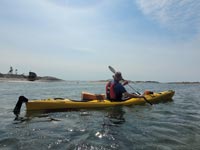
Bob and Sofia from Nature Travels spend 3 days/2 nights combining adventure and comfort as they go Self-guided Sea Kayaking in the Stockholm Archipelago in June.
Simply put, it’s hard to imagine a better place for kayaking than the Stockholm Archipelago.
With 30,000 islands (or 50,000, depending on who’s counting and how) of varying shapes and sizes, mostly spaced just the right distance apart so that you can easily hop between them and avoid crossing large open bodies of water, combined with the privileges of wild camping afforded by the Swedish Right of Public Access, it’s easy to think that the whole area was created with kayakers in mind.
Sofia and I were heading to our summer house in the Archipelago to celebrate Midsummer together with the Swedish side of the family, and this was a perfect opportunity to add a few extra days at the start of the trip to do our Self-guided Sea Kayaking in the Stockholm Archipelago tour.
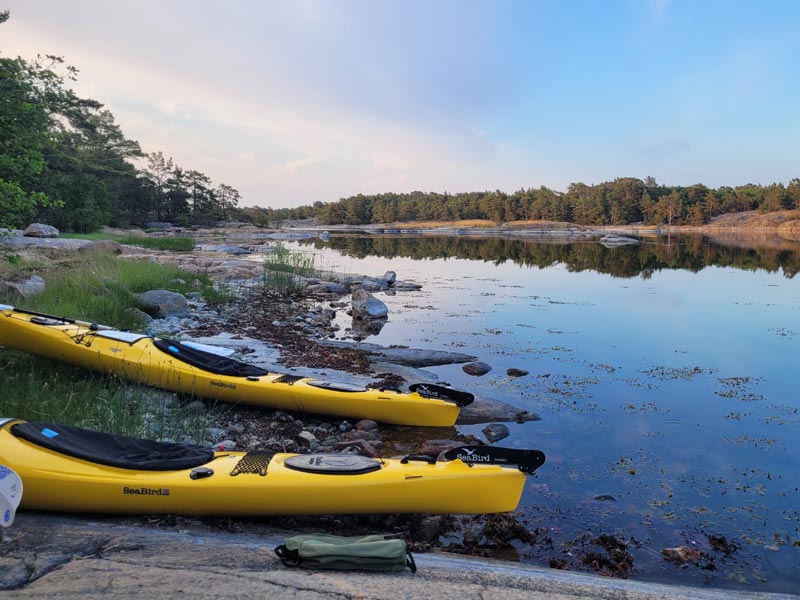
This tour is a wonderful combination of adventure and convenience. Literally everything except your own personal clothing can be provided for you, making it the ideal choice if you’re doing other things with your time in Sweden before or after the tour and don’t want to be travelling with lots of gear, or if you simply enjoy travelling light (which, given that even hand luggage is now charged separately as part of your air ticket, can offer a real advantage).
With a choice of single or double kayaks, circular or A-B routes and a great deal of flexibility to adapt the tour depending on your ability and wind and weather conditions, this can be a wonderful introduction to kayaking for the novice or a challenging expedition for the more experienced.
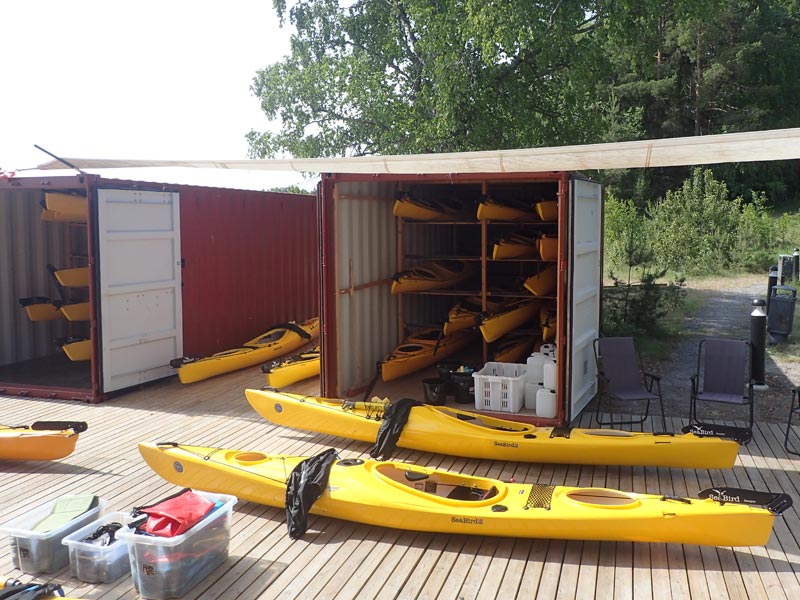
We offer two options for this tour:
- The “Standard” package gives you all the kayaking, camping and cooking equipment you need, as well as a kayak jacket, gloves and even a rainhat! Just bring you, your clothes, and some food for the trip.
- The “Full-service” option adds even more to the experience and includes transfer to/from central Stockholm to the kayak centre, some extra camping luxuries (including an environmentally friendly outdoor “spa kit”), a more in-depth introduction session at the start and also the option to add a provisions package, which comes with recipe cards and everything you need for meals and snacks during the tour.
Whichever option you choose, the core equipment and route possibilities for the tour are the same – we were doing a bit of a hybrid of the two, as we were making our own way by bus to and from the kayak centre but choosing the “extra” equipment and also the provisions package to have a chance to try everything out.
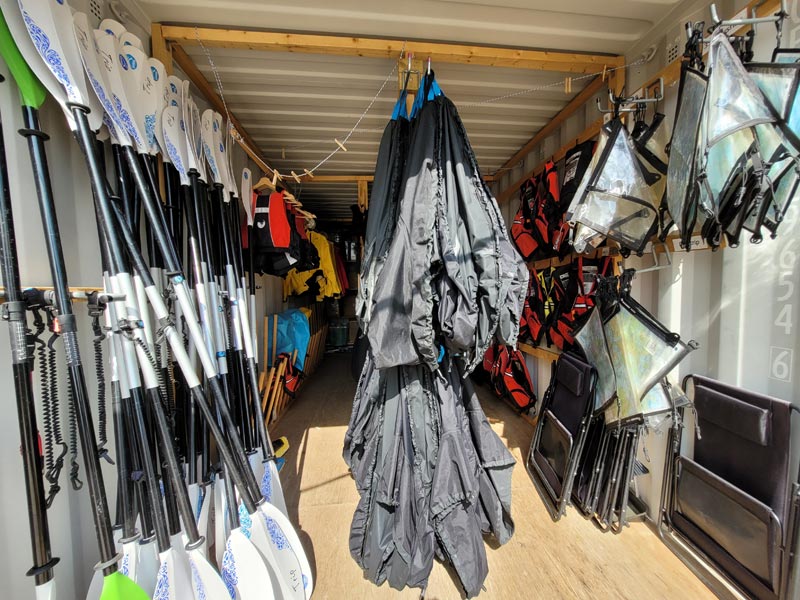
We would be starting and ending at Stavsnäs, which is easy to reach from central Stockholm by direct bus from Slussen (itself just a few stops from Stockholm Central station). The ticketing for public transport in the Stockholm city region has recently been simplified, and you now just need to tap your contactless payment card before boarding a subway train or when getting onto a bus. This then gives you up to 75 minutes of travel (the total journey can be longer than 75 minutes, provided the last leg of your journey is started within the 75-minute window) anywhere in the region for, at time of writing, 39 SEK/person. That’s around £3!
Stavsnäs is the most common start/end point for the kayaking, which brings you quickly into the “outer archipelago” landscape, where the forest begins to give way to more open, rocky islands.
There is also the option to begin and/or end at an alternative point, Sollenkroka, from where you can paddle towards Stavsnäs and continue further onwards if you wish. Sollenkroka can be a good choice if weather conditions are challenging or if you wish to do a point-to-point itinerary. Starting from there brings you through the beautiful forested islands of the middle Archipelago (where Sofia and I have our summer house).
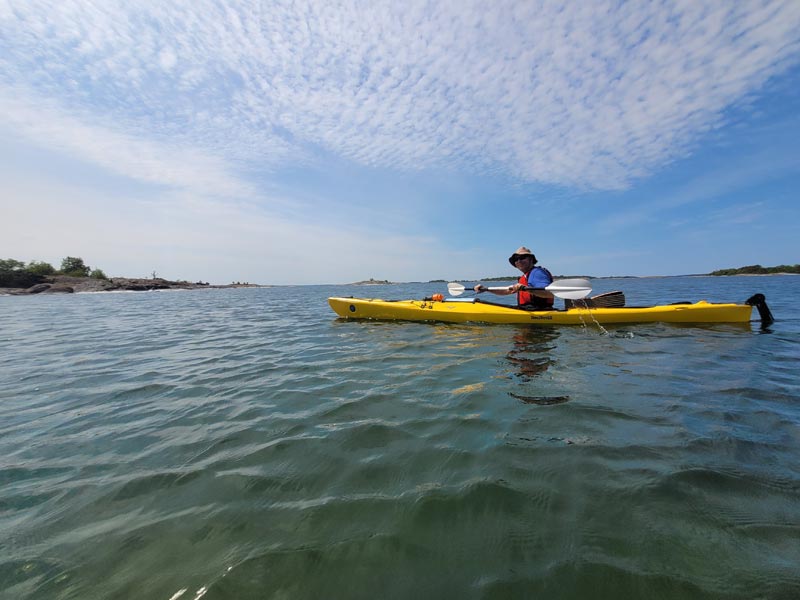
We disembarked at Stavsnäs harbour and walked to the kayak centre, where over coffee and biscuits we spent a good deal of time going through all the equipment, looking at the maps and weather forecast and discussing the most suitable route for the days ahead given the likely wind direction and other factors.
There are several different routes you can take for your tour. We had 3 days/2 nights to go exploring, and decided that we’d head south. As with any kayak tour, it’s important to be prepared to adapt your plans as you go along, so we weren’t sure how far we’d get. But we’d aim for a group of islands known at Jungfruskär, perhaps taking a circular route on the way back via Bullerön or returning the way we came depending on the wind.
We would be using two single kayaks. There was so much lovely, high quality kit that we really wondered if we would fit it all in! But there’s a lot more storage space in a kayak than you think, and provided you pack in small, soft bags (you can borrow as many waterproof bags as you need) to make the most of all available room, it’s amazing how much you can squeeze in.
Eventually we were all packed, including fresh water containers for our drinking and cooking water and picnic bags with all the provisions,.
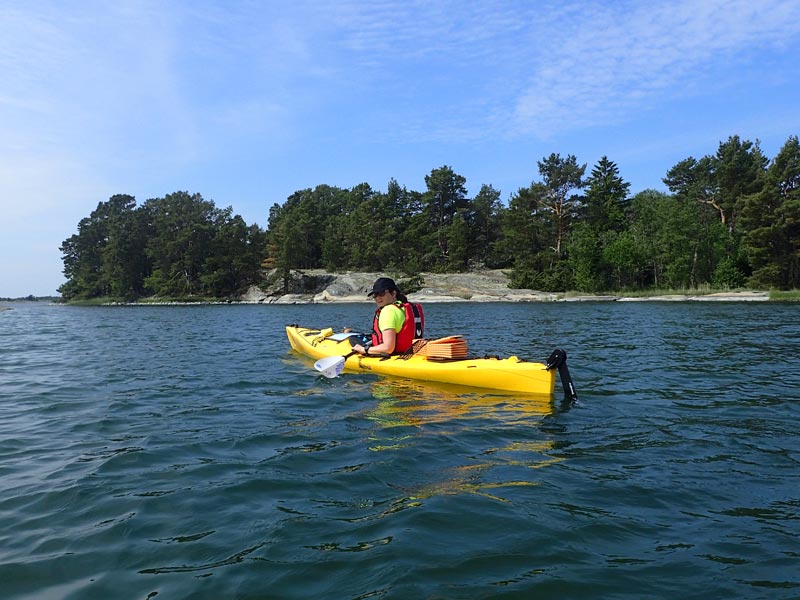
It was mid-afternoon by the time we took to the water, but even here in the Stockholm Archipelago, relatively far south by Swedish standards, it hardly gets dark at all in June, so we had many hours of daylight ahead of us.
It was lovely to be out on the water. The first part of the trip took us to the south of Runmarö, surrounded by forested islands dotted with summer houses, making our way through the labyrinthine archipelago, at times paddling more open water between the islands (but never more than a few hundred metres at a time) and at others sneaking through tiny gaps that no other craft would be able to navigate.
As we continued south, we soon left most of the summer houses behind and entered an area which felt remarkably wild.
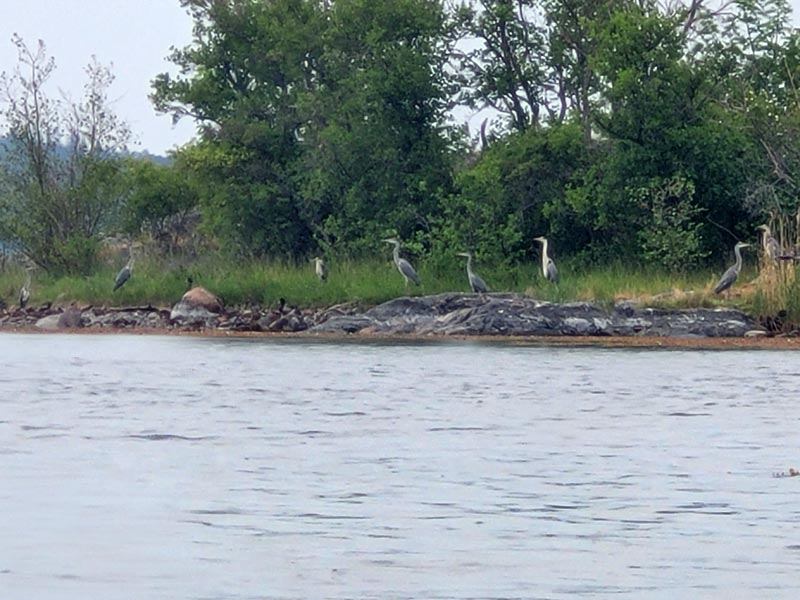
We spotted the first of what were to be many, many herons. Herons have always been a common sight in the archipelago, but in recent years populations have grown significantly in some areas, and on this trip there were herons all over the place! At times, almost everywhere we looked there was one of these graceful, majestic birds standing statue-like on a rock or flapping lazily across the sky, and at one point we saw 13 birds together, which was definitely a first for me.
There was also a wealth of other birdlife. Being spring and so breeding season, the surface of the water would frequently explode to life as we paddled round a corner and startled a family of ducklings or swans.
There are a number of designated bird nesting reserve areas in this region, which are clearly marked on the maps. These should be completely avoided, and we gave them a wide berth as we paddled through.
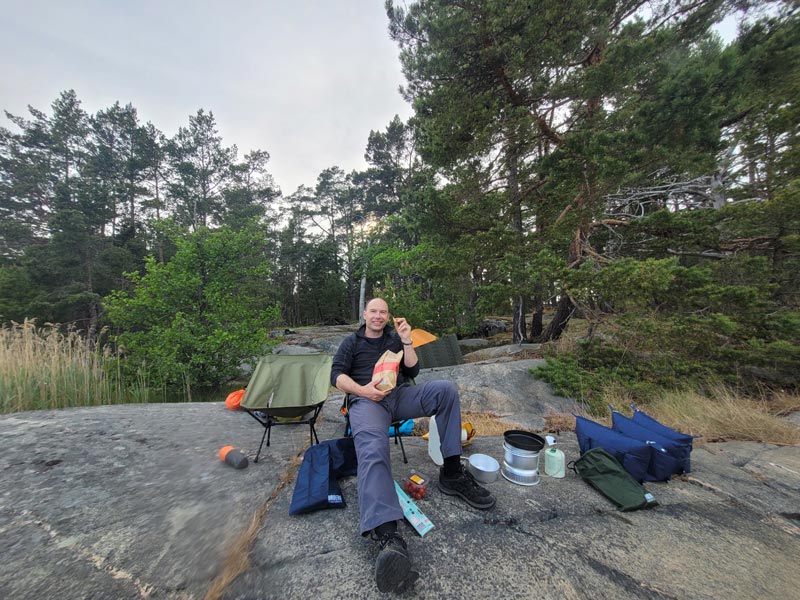
We’d deliberately planned to take it easy during this trip, concentrating on enjoying the surroundings and testing out the equipment – it’s a holiday after all! – so when we came across an idyllic camping spot in the late afternoon, nestled in a sheltered section between two long islands, we decided to make camp early, even though we could have kept paddling for hours.
And so began our first lazy, lovely evening of wild camping in the archipelago. We pitched the tent and set about exploring the provisions.
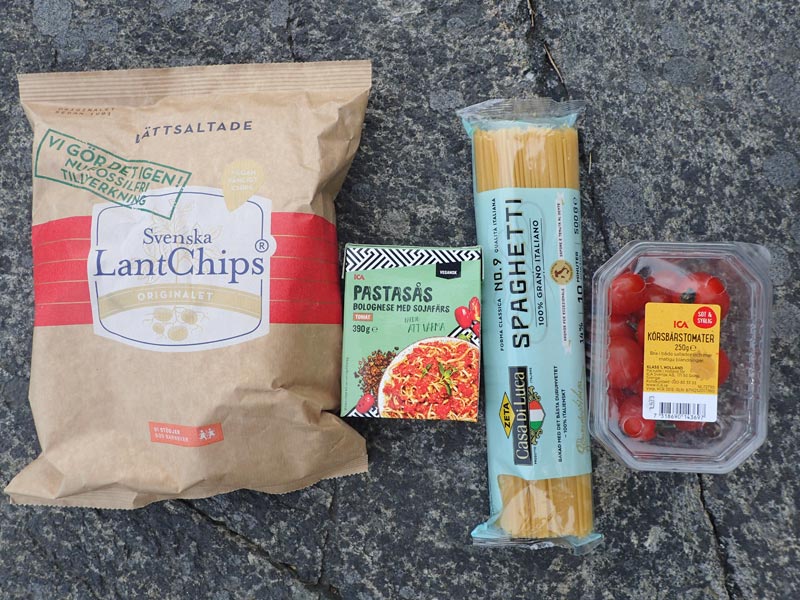
We certainly wouldn’t be dropping any kilos on this trip, and we sat contently watching the birds and eating crisps while our dinner bubbled gently on the stove. It really felt like we had the world to ourselves.
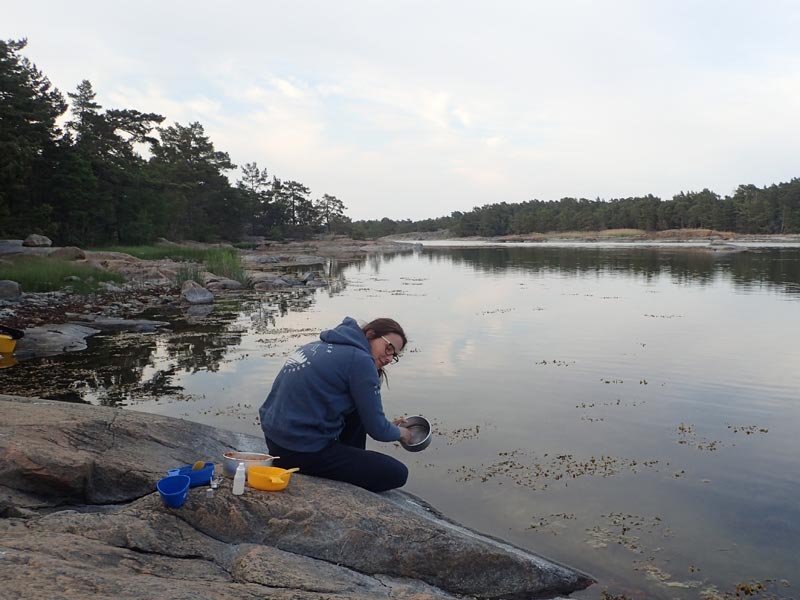
At last the sun began to drop towards the horizon and it was time for bed. With both inflatable and foam sleeping mats, and a very nice sleeping bag, we were sound asleep in no time. Zzzzzz…..
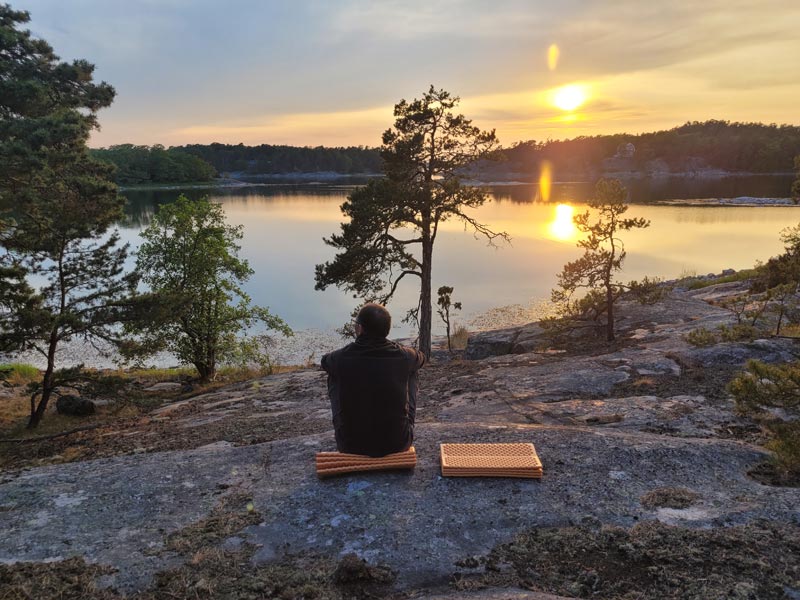
We awoke to a clear, warm morning, and a perfect opportunity to try out the “outdoor spa kit” that is included with the Full Service package option, which contains (at the time of writing – contents may vary) environmentally friendly shower gel/shampoo, conditioner and mosquito repellent from local Swedish manufacturer Sjö & Hav.
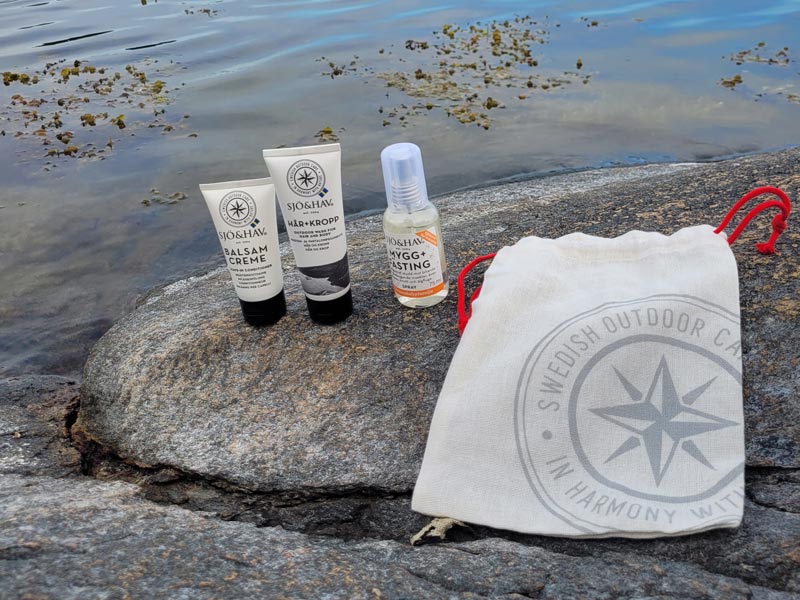
A full hair wash wasn’t really necessary, and it was still a bit chilly for a full swim, but it was lovely to sit on the smooth rocks in the morning sunshine and have a wash in the clear waters of the Baltic. Being only very slightly salty, there’s none of the stickiness that you get with sea water and it’s more like bathing in a lake. What a great start to the day!
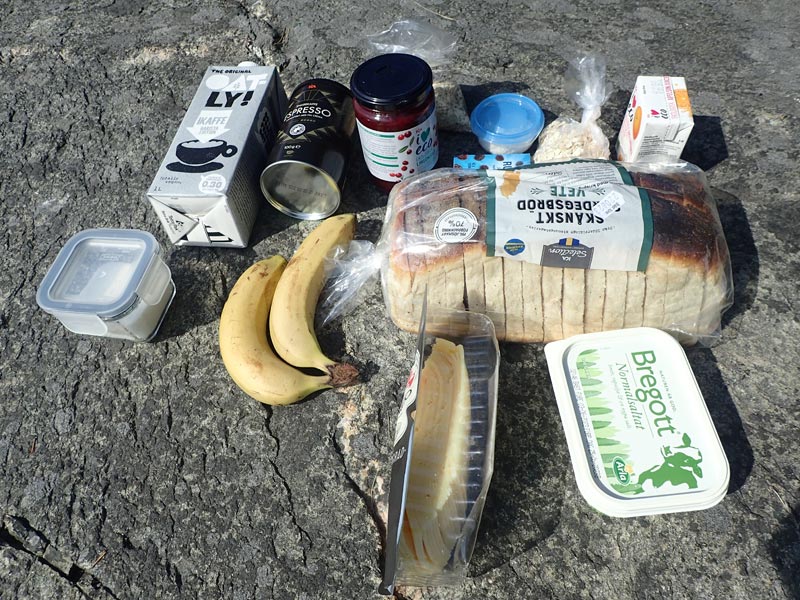
After a leisurely and over-indulgent breakfast, we loaded the kayaks and continued south. Apart from the occasional sailing boat or small motorboat moored up for the day, we saw hardly anyone else at all. The landscape began to change, with the islands becoming smaller and more rocky – typical of the outer archipelago. The sun was shining and there was a light tailwind, and for a good while we did almost no work at all as we drifted serenely between the islands pushed along gently by the wind.
This was blissful, but with the wind behind us we were eating up the kilometres quickly. With the wind expected to strengthen, we were conscious that we’d need to paddle back this way again tomorrow, which would then be into the wind – a much more tiring proposition! So we kept an eye on the map to make sure we didn’t end up going too far.
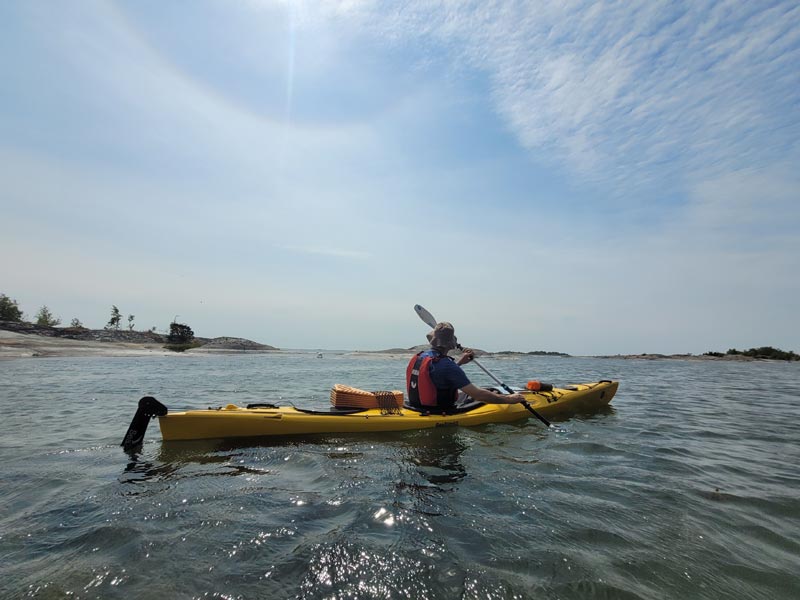
We stopped for lunch at a beautiful little bay, before deciding to head back the way we’d come and camp near the island of Ormskär, which we’d passed earlier in the day. It was quite breezy by the time we got back there, and it took a while to pick a suitably sheltered camping spot. But we found one – with a lovely bit of flat rock that looked like it was just made to pitch a tent on!
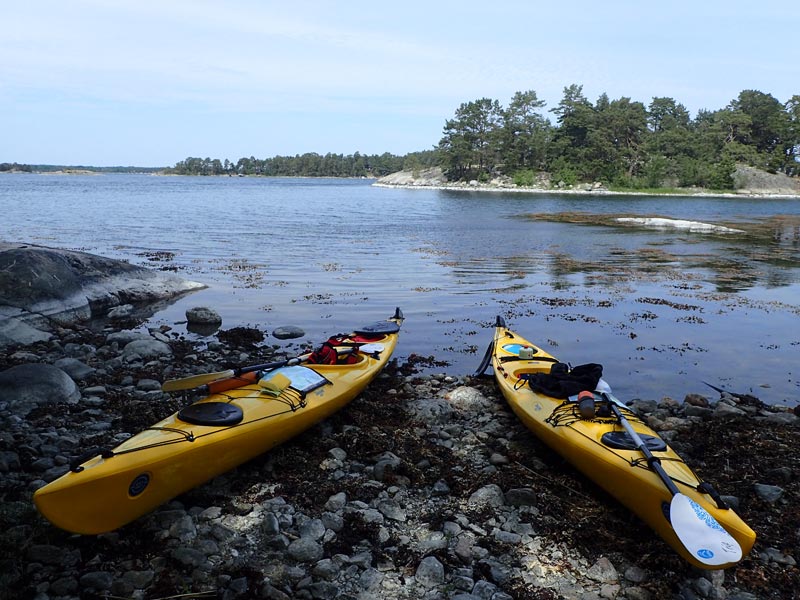
When pitching your tent on rock, you can’t use the tent pegs of course. You need to weigh the lines down with stones (and following the principle of Leave No Trace, don’t forget to put the stones back where you found them later). Provided it’s not too windy, this generally works very well – although it’s always a good idea to leave something heavy in the tent just in case of strong gusts!
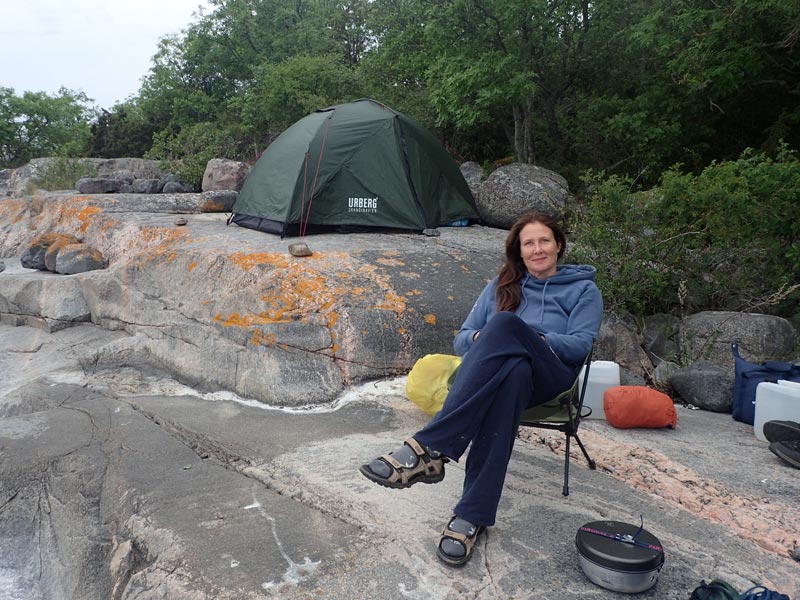
It was a different view this evening – instead of the constant procession of birds, we had a wide vista of the Baltic to admire as we dined on vegetarian Swedish meatballs with mashed potato and lingonberry jam with a starter of crispbread and pickled herring.
Further out we could see the islands around Bullerön that we’d thought we might get to, but with the wind we’d decided to return (with some variations) the way we came.
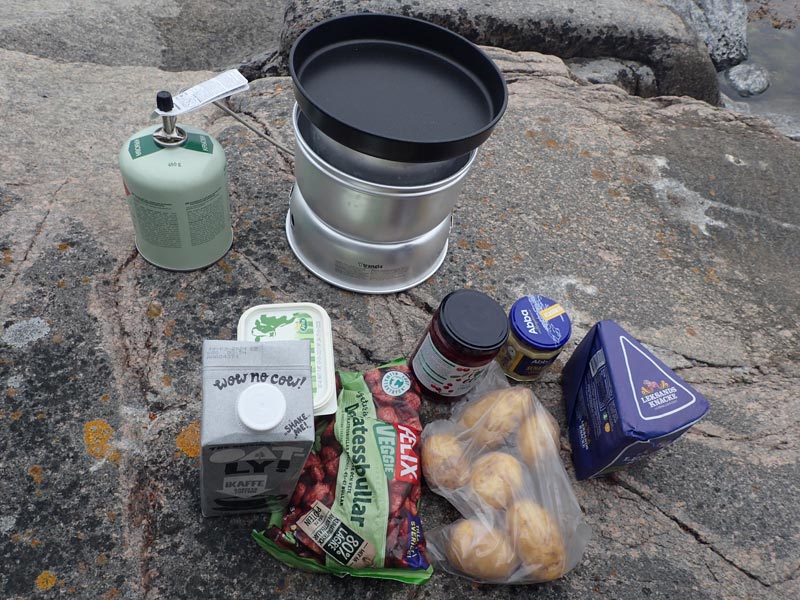
When we awoke to begin our final day’s paddling, it was raining and the skies looked ominous, though the rain conveniently stopped for breakfast. The wind was stronger and the water was choppy. It had been a good decision not to go too far south yesterday – the paddle back today was going to be harder work!
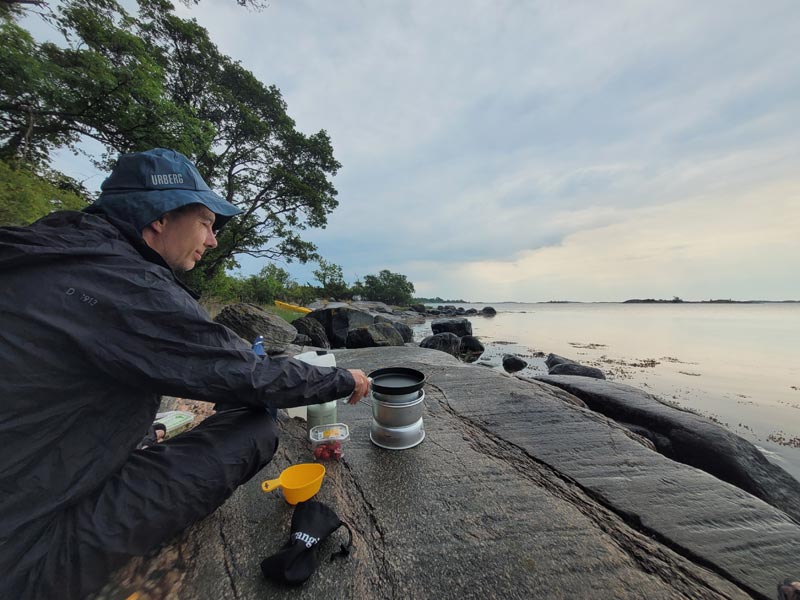
Sunshine and calm waters are wonderful of course, but the archipelago has many different moods, and also looks stunning when the weather is less perfect. The rain brings out the colours on the rocks and the dripping forests sparkle with light when the sun breaks through.
The first part of our paddle today was a bit of a struggle, as we were going directly into the wind and there were quite a few open areas to cross. But we took it gently and steadily, hopping our way one section at a time and taking the shortest routes between the islands with rests in between. The kayaks are very stable, especially when fully loaded, and it was actually great fun to splash our way along.
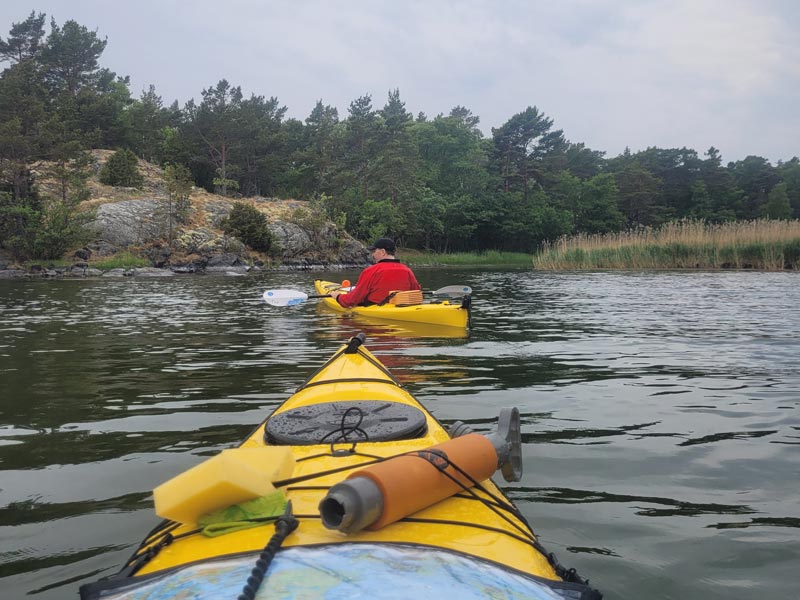
As we moved north, we entered a much more sheltered area, and the hard work was suddenly all behind us. It was raining again as we stopped for lunch, but that really didn’t matter – as the Swedes say, “There’s no such thing as bad weather, only bad clothes”. It was that gentle summer rain which makes the world feel fresh and new.
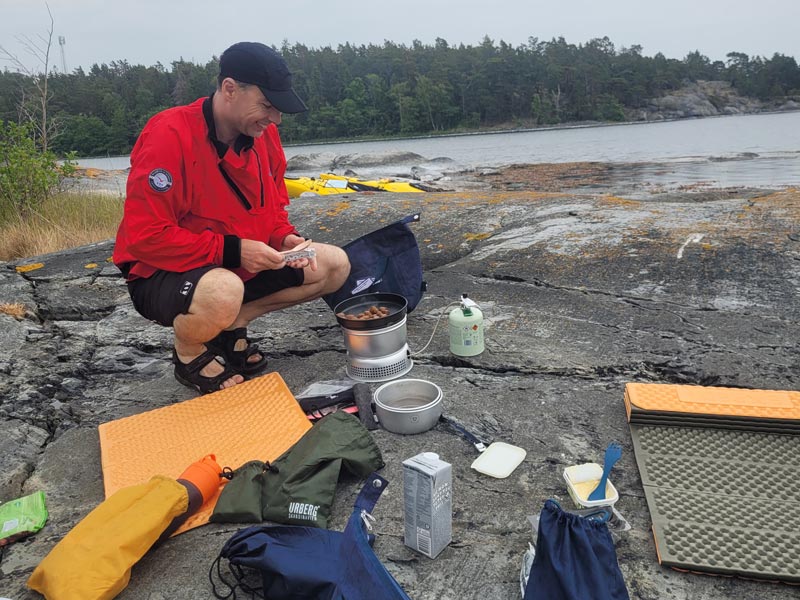
We reached the kayak centre again in the afternoon, and our little trip had come to an end. There’s a shower and even sauna available on return if you wish, but with Sofia’s mum expecting us for dinner, we headed straight to the bus and back to Stockholm.
We had enjoyed it immensely. We’d been active and fully “out” in nature – it had been a proper outdoor experience in every sense – but we’d also been extremely comfortable and very well fed. Hmmm…I could get used to this!
Two nights out is a good length of time if you’re looking for a relatively short tour but is still enough for an immersive experience, with time to really get into the rhythm of the trip, cover some distance and discover a variety of beautiful areas.
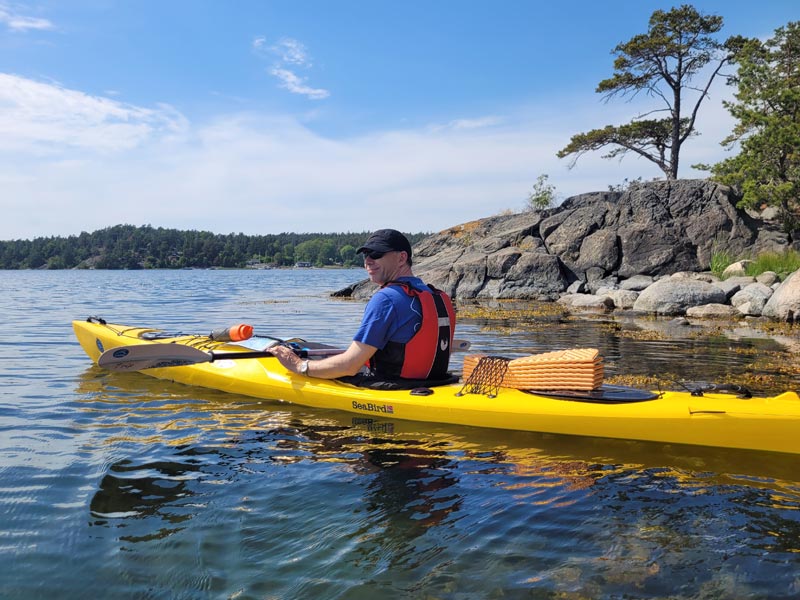
If you have longer to spend and are looking for more of an adventure, the archipelago is a huge outdoor playground to explore. Depending on the route you take, there are a number of places where you can re-supply with drinking water and food if you need to, making it easy to be out for a week or more.
The Stockholm Archipelago is a unique and, if you’re not a Swede, surprisingly little-known wonder. It truly is a paradise for kayaking, and so easy to get to. What are you waiting for?
Best regards
Bob & Sofia
Nature Travels offers a wide range of self-guided kayak tours in Sweden, Finland and Norway. For solo travellers, or those who enjoy the added dimension of a guided experience, we also offer guided kayaking and instructional courses. Browse our full range of kayak tours or compare the tours to help you decide!
